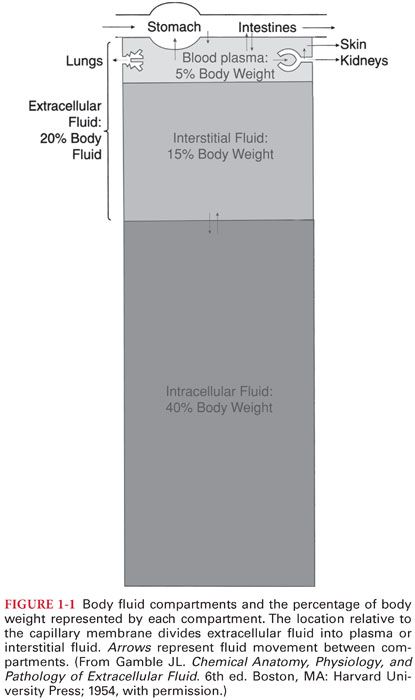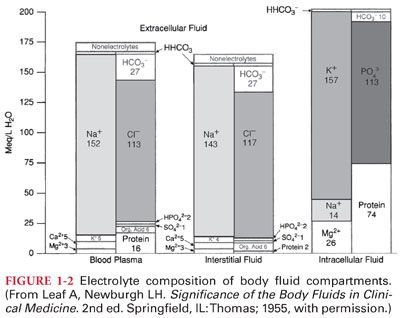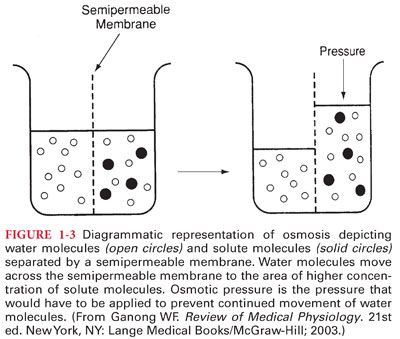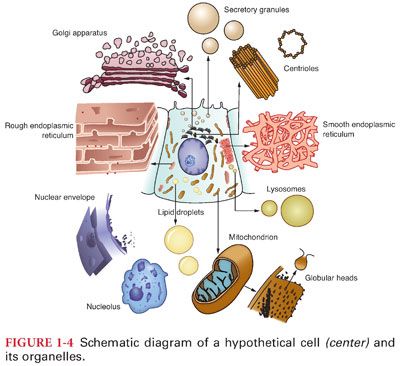B. Body fluids can be divided into intracellular and extracellular fluid, depending on their location relative to the cell membrane (Fig. 1-1).

1. Interstitial fluid is present in the spaces between cells.
2. Plasma is in dynamic equilibrium with the interstitial fluid through pores in the capillaries; the interstitial fluid serves as a reservoir from which water and electrolytes can be mobilized into the circulation.
3. The normal daily intake of water (drinks and internal product of food metabolism) by an adult averages 2.5 L of which about 1.5 L is excreted as urine, 100 mL is lost in sweat, and 100 mL is present in feces.
II. Blood Volume
A. The average blood volume of an adult is 5 L, comprising about 3 L of plasma and 2 L of erythrocytes (varies with age, weight, and gender).
1. In nonobese individuals, the blood volume varies in direct proportion to the body weight, averaging 70 mL/kg for lean men and women.
2. The greater the ratio of fat to body weight, the less is the blood volume in milliliters per kilogram because adipose tissue has a decreased vascular supply.
B. The normal hematocrit is about 45% for men and postmenopausal women and about 38% for menstruating women, with a range of approximately ±5%.
III. Constituents of Body Fluid Compartments (Fig. 1-2)

A. An unequal distribution of ions results in establishment of a potential (voltage) difference across cell membranes.
B. The constituents of extracellular fluid are carefully regulated by the kidneys so that cells are bathed in a fluid containing the proper concentrations of electrolytes and nutrients.
C. Trauma is associated with progressive loss of potassium through the kidneys due, in large part, to the increased secretion of vasopressin and, in variable part (depending on the type of surgery), to the role of nasogastric suctioning and direct potassium loss.
IV. Osmosis is the movement of water (solvent molecules) across a semipermeable membrane from a compartment in which the nondiffusible solute (ion) concentration is lower to a compartment in which the solute concentration is higher (Fig. 1-3).

V. Tonicity of Fluids
A. A solution of 5% glucose in water is initially isotonic when infused, but glucose is metabolized so the net effect is that of infusing a hypotonic solution.
B. Lactated Ringer’s solution plus 5% glucose is initially hypertonic (about 560 mOsm/L), but as glucose is metabolized, the solution becomes less hypertonic.
VI. Fluid Management
A. The goal of fluid management is to maintain normovolemia and hemodynamic stability.
B. After 20 to 30 minutes, an estimated 75% to 80% of an isotonic saline or a lactate-containing solution will have distributed outside the confines of the circulation, thus limiting the efficacy of these solutions in treating hypovolemia (ability of crystalloids to restore perfusion in the microcirculation is doubtful).
VII. Dehydration
A. Loss of water by gastrointestinal or renal routes or by diaphoresis (excessive sweating) is associated with an initial deficit in extracellular fluid volume.
B. The ratio of extracellular fluid to intracellular fluid is greater in infants than adults (dehydration develops more rapidly and is often more severe in the very young).
C. Clinical signs of dehydration are likely when about 5% to 10% (severe dehydration) of total body fluids have been lost in a brief period of time.
1. Physiologic mechanisms can usually compensate for acute loss of 15% to 25% of the intravascular fluid volume.
2. A greater loss places the patient at risk for hemodynamic decompensation.
VIII. Cell Structure and Function. The basic living unit of the body is the cell. (It is estimated that the entire body consists of 100 trillion or more cells of which about 25 trillion are red blood cells.)
A. Cell Anatomy (Fig. 1-4)

Stay updated, free articles. Join our Telegram channel

Full access? Get Clinical Tree


